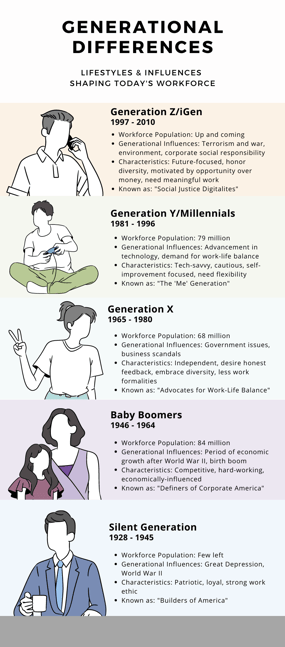Navigating the Labor Shortage by Understanding Generational Differences
by Faith Boone, on Mar 21, 2022 9:21:03 PM

The workforce is experiencing significant shifts in the needs of key stakeholders (employees, customers, partners, etc.) and these shifts are forcing companies to better understand the importance of embracing change and taking a closer look at workplace culture. The supply chain industry has spent years developing programs to deter the ongoing struggles linked to the labor shortage, including ways to recruit and retain new talent. What leadership is recognizing today is that the shifts in the workforce can be correlated to the uniqueness behind each different generation of workers, and how their environment influenced their perceptions of careers and work-life balance.
The Demand for New Talent
 There is a lot of diversity in the workplace today from a generational perspective, according to Marilyn Surber, Transportation Leader for Tenstreet, a company that specializes in recruiting, safety and onboarding employees in transportation, warehousing and logistics. “Now, it is up to the companies searching for new talent to embrace everyone and anyone who is interested in the field.”
There is a lot of diversity in the workplace today from a generational perspective, according to Marilyn Surber, Transportation Leader for Tenstreet, a company that specializes in recruiting, safety and onboarding employees in transportation, warehousing and logistics. “Now, it is up to the companies searching for new talent to embrace everyone and anyone who is interested in the field.”
She points out that some companies can have up to five generations in the workplace, and understanding the characteristics and differences of each is important. “We all have to work together,” Surber says.
“We have a lot of diversity in the workplace now, whether that's age diversity, generational diversity, gender diversity. We're in a place where we have to embrace all people no matter where they come from and who they are.”
For example, the average age of an over-the-road truck driver is 55 years old, with an average lifespan of 61 years old, according to Surber. With older generations leaving the industry or retiring, the talent that needs to be recruited into the industry are the younger generations that are looking for their next career path. And that’s just one small but critical portion of the workforce in the supply chain.
 Understanding Different Generations in the Workplace
Understanding Different Generations in the Workplace
Surber says when discussing the labor shortage, the number of people in each generation is important. She identified the five generations of people working today and shared specific characteristics about each. Her information revealed innate differences between drivers based on their generational influences. See Illustration on Generational Differences to the right.
You have to be deliberate and intentional when hiring for the industry, whether it be an entry-level employee or a C-suite executive, says Vanessa Hernandez, Director of Carrier Resource Teams at J.B. Hunt.
“When you do that, word gets out,” she says. “You have to expand your reach and have a culture that people talk about. A culture that’s easy to understand and can be communicated to anyone who asks.”
 Hernandez says doing more with social media and engaging high schools is important when recruiting individuals into logistics. “The industry is good with college-level internships,” she says. “Apprenticeships are a great idea. Shadowing is good. Diversity and inclusion, and let's get them excited about coming into logistics, warehousing and transportation. If you're interested in something we got something.”
Hernandez says doing more with social media and engaging high schools is important when recruiting individuals into logistics. “The industry is good with college-level internships,” she says. “Apprenticeships are a great idea. Shadowing is good. Diversity and inclusion, and let's get them excited about coming into logistics, warehousing and transportation. If you're interested in something we got something.”
 Old Dominion Freight Line is trying to get into as many high schools as possible and talk to students about the endless number of opportunities to work in the industry, according to Dee Dee Cox, Vice President of Human Resources for the major LTL carrier. The company is also reaching out to teachers to spread the word and identify students with interests that may be a fit for a particular position.
Old Dominion Freight Line is trying to get into as many high schools as possible and talk to students about the endless number of opportunities to work in the industry, according to Dee Dee Cox, Vice President of Human Resources for the major LTL carrier. The company is also reaching out to teachers to spread the word and identify students with interests that may be a fit for a particular position.
“Trucks touch everything and we have to make sure everyone we talk to understands the logistics industry and how vital we are,” she says. “Every generation wants to have a purpose. During the pandemic, I think every person in transportation understood how meaningful their job was when we were so short of supplies.”

Acknowledge Diversity, Equity, and Inclusion
Hernandez says J.B. Hunt employs resource groups including ones for women, African-Americans, veterans, Latinos, and more.
“It's really about creating those opportunities and then letting people know that they're out there. We encourage all of our folks to join one of these groups – join two, join three, get engaged, get involved, it gives you exposure, it gives you visibility, you learn how to gain influence, you learn how to improve your communication skills, you learn so much,” she says.
Cox says Old Dominion offers its employees opportunities to give back to the community through volunteering, and the company also takes a personalized interest in each employees’ career path.
“What we’ve done in our culture to engage each one of these generations is we have one-on-ones quarterly,” she says. “Their manager sits down with them four times a year and one of those talks is always about your career. Where are you? Where do you want to go? Where do you want to be? Let's see if we can get there.”
 Opportunities exist for smaller companies as well. According to Tierra Kendrick, CEO of TAKL Logistics (a specialist in temperature-controlled freight), her multi-generational team is growing as her company expands. To recruit more to her workforce, she focuses on advocating for drivers. She checks in with her team to see how they feel about their jobs and if they want to grow.
Opportunities exist for smaller companies as well. According to Tierra Kendrick, CEO of TAKL Logistics (a specialist in temperature-controlled freight), her multi-generational team is growing as her company expands. To recruit more to her workforce, she focuses on advocating for drivers. She checks in with her team to see how they feel about their jobs and if they want to grow.
“To understand the importance of our drivers, I tell my employees we are not only concerned with the customer or the supplier manufacturer, but we're advocates for drivers as well,” she says. “We’re showing that we're making a difference in people's lives. This is their livelihood. When you talk about being passionate about drivers, I say we are tackling logistics across the globe and changing the faces of the logistics industry one dispatch at a time. Every time we speak to a carrier or somebody at a warehouse, we’re advocating for those drivers.”
Recruitment Efforts for Generations to Come
Suber says there are things to remember about the Millennials and iGens if the industry wants to be successful in recruiting the next generation of drivers.
“They're going to demand that feedback,” she says. “They're going to demand that career path and that open dialogue. In your businesses, if we know that that's what that generation wants, it's our responsibility as people running these companies and running our industry to say okay, how do we make it easy for these other generations to do this? How do we make it easy for these generations to join the logistics, transportation, or supply chain industry and understand the things that are most important to them.”
Kendrick says making transportation and distribution sexy by showing the number of avenues you can take for a career path will help the industry recruit and retain the best workers.
“Showing people of all ages, genders and races that we're out here doing great things, we're making a difference, and we not just all older white males in this industry makes it more attractive to more people with diverse backgrounds," she says. "There are so many different career options in transportation, warehousing, and supply chain management.”
This article was originally featured in Edition 1 of 2022 of Food Chain Digest magazine. Download the digital version today!



